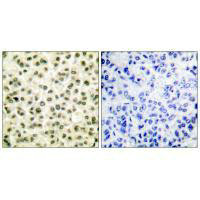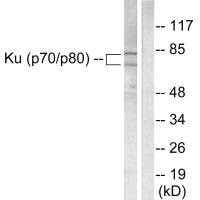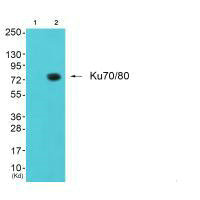
Immunohistochemical analysis of paraffin-embedded human breast carcinoma tissue using Ku70/80 antibody.
XRCC6/XRCC5 Antibody
CSB-PA834315
ApplicationsImmunoFluorescence, Western Blot, ELISA, ImmunoHistoChemistry
Product group Antibodies
ReactivityHuman, Mouse, Rat
TargetXRCC6
Overview
- SupplierCusabio
- Product NameXRCC6/XRCC5 Antibody
- Delivery Days Customer20
- ApplicationsImmunoFluorescence, Western Blot, ELISA, ImmunoHistoChemistry
- CertificationResearch Use Only
- ClonalityPolyclonal
- ConjugateUnconjugated
- Gene ID2547
- Target nameXRCC6
- Target descriptionX-ray repair cross complementing 6
- Target synonymsCTC75, CTCBF, G22P1, KU70, ML8, TLAA, X-ray repair cross-complementing protein 6, 5'-dRP lyase Ku70, 5'-deoxyribose-5-phosphate lyase Ku70, 70 kDa subunit of Ku antigen, ATP-dependent DNA helicase 2 subunit 1, ATP-dependent DNA helicase II, 70 kDa subunit, CTC box binding factor 75 kDa subunit, DNA repair protein XRCC6, Ku autoantigen p70 subunit, Ku autoantigen, 70kDa, X-ray repair complementing defective repair in Chinese hamster cells 6, lupus Ku autoantigen protein p70, thyroid autoantigen 70kD (Ku antigen), thyroid autoantigen 70kDa (Ku antigen), thyroid-lupus autoantigen p70
- HostRabbit
- IsotypeIgG
- Protein IDP12956
- Protein NameX-ray repair cross-complementing protein 6
- Scientific DescriptionSingle-stranded DNA-dependent ATP-dependent helicase. Has a role in chromosome translocation. The DNA helicase II complex binds preferentially to fork-like ends of double-stranded DNA in a cell cycle-dependent manner. It works in the 3-5 direction. Binding to DNA may be mediated by XRCC6. Involved in DNA non-homologous end joining (NHEJ) required for double-strand break repair and V(D)J recombination. The XRCC5/6 dimer acts as regulatory subunit of the DNA-dependent protein kinase complex DNA-PK by increasing the affinity of the catalytic subunit PRKDC to DNA by 100-fold. The XRCC5/6 dimer is probably involved in stabilizing broken DNA ends and bringing them together. The assembly of the DNA-PK complex to DNA ends is required for the NHEJ ligation step. Required for osteocalcin gene expression. Probably also acts as a 5-deoxyribose-5-phosphate lyase (5-dRP lyase), by catalyzing the beta-elimination of the 5 deoxyribose-5-phosphate at an abasic site near double-strand breaks. 5-dRP lyase activity allows to clean the termini of abasic sites, a class of nucleotide damage commonly associated with strand breaks, before such broken ends can be joined. The XRCC5/6 dimer together with APEX1 acts as a negative regulator of transcription. Shankar Mitra, AAPG Bulletin, Oct 2006; 90: 1565 - 1584. Ward Giffin, Mol. Cell. Biol., Jun 1999; 19: 4065 - 4078. Huichen Wang, Nucleic Acids Res., Sep 2003; 31: 5377 - 5388. Boris Kysela, J. Biol. Chem., Jun 2003; 278: 22466 - 22474.
- ReactivityHuman, Mouse, Rat
- Storage Instruction-20°C or -80°C
- UNSPSC41116161








